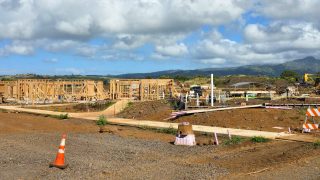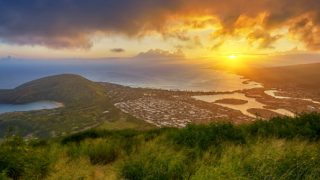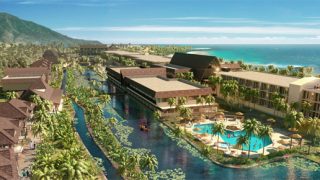Last week, after a high tide event, part of the sidewalk and nearby trees fell into the water at much loved Kaanapali Beach. The area affected was around the Kaanapali Alii Resort, which fronts the oceanfront walk between the Hyatt Regency and Black Rock. It wasn’t unexpected either, following 40 years of continuous beach erosion. Most recently, the State says that the severity is increased with sea level rise and record high water levels. This is only expected to get worse.
Clearly, things will have to change as climate change pushes the shoreline to where condos and hotels are currently located.
State DLNR said, “Right now is literally the time when it’s most affordable and easiest for us to get engaged in managed retreat. Figuring that out is a problem, but we’re not the only community in the world that has this issue. Literally, every coastal community does.”
DLNR has proposed a Kaanapali Beach restoration project which could provide extra time needed before bigger changes ahead.
Beach access will be limited.
There will be heavy equipment during the work, and the site will be considered active construction with limited public access. That will include all areas at or around the work project to protect beach visitors from dangerous contact with the equipment and materials.
The project is scheduled to take two months, which in Hawaii might mean it will take significantly longer. Work is planned 12 hours/day, 7 days/week. The project is scheduled to take place from October until December.
First approach: Sand nourishment. Long-term approach: retreat from eroding locations.
The Kaanapali Beach Restoration Project will bring about 75k cubic yards of sand to the area. While that’s said to be equal to two dozen Olympic swimming pools worth, it’s just a drop in the bucket. The State plans to “restore coastal sandy habitat that extends across the terrestrial/marine boundary for immediate short-term remediation.” In concert with the Kaanapali Operations Association, the State plans to preserve the beaches with sand restoration and berm enhancement.
The project is intended to temporarily mitigate rising water levels and coastal erosion.
Not only will this improve the situation for visitors, but the State adds that “restoring the beach back to its former width and volume to make Kaanapali Beach more resilient to the impacts of coastal erosion and high wave overwash. It will increase the beach width by 41-78 feet.
How will this project happen?
The system for increasing the sand volume at Kaanapali Beach consists of using a moored crane barge with a clamshell bucket, two additional sand transport barges, tugboats, pus two landing areas at both ends. The crane barge will pick sand up from the seafloor and drop it onto large barges. Once filled, the barge will be taken to off-loading sites, then transferred to the shore along a bridge and trestle system using a to-be-determined methodology selected. Equipment on the beach will transfer the sand to the placement area. The entire process will move daily as the project continues. No excavation is planned, with the new sand merely being added onto the existing beach.
Minimal environmental impact planned.
The state “has developed extensive best management practices through the environmental review process and consultation with natural resource management agencies to ensure that coral and other marine organisms and resources are protected throughout project construction.”
This seems like wishful thinking, given that all parts of the shoreline are natural habitats, and the long-term effects of such shoreline manipulation are temporary at best. Studies conducted in California and Australia on the effects of such manipulation, often referred to by the euphemistic term of “nourishment”, have shown huge impacts on the diverse community of invertebrates that populated these areas. There is little reason to think that the same would not hold true for Hawaii beaches.
Throughout the State, many beachfront properties have employed seawalls to both hold back the waves and expand the footprint of useable land right up to the waterline. Such stop-gap measures are expensive, detrimental to shorelines, and ultimately ineffective. Natural beaches move and shift with the seasons and weather, with the sand being naturally replenished both through wave action bringing sand onto the shore, and by natural erosion from the shore itself.
Even without climate-driven sea level rise, the natural progression of the shoreline on all of the Hawaiian islands is inward (except for some parts of Hawaii island).
Sea level rise has only accelerated this trend, and efforts to create coastal barriers and “shore up” existing ones only exacerbate this loss in the long run. Studies and experience have shown that such shoreline armoring speeds up shoreline erosion by altering the interaction between ocean currents and the shoreline, leading to the loss of beachline directly in front of the walls, as well as accelerated erosion of nearby unarmored areas. Beaches directly adjacent to the seawall experience an effect known as “flanking erosion” which causes a further loss of sandy beaches. Heavily armored shorelines also experience a dramatic loss of biodiversity due to the erasure of the various habitats inherent to a naturally sloping, sandy shoreline.
Truth be told, many of these properties should never have been allowed to build so close to the shoreline.
Significant money has been made in developing and marketing what is seen as prime real estate. The long-term effects of such development have largely gone unexamined or been ignored in the interest of short-term profit. We are now faced with a sticky situation where scads of multi-million dollar properties cluster along the beaches and former beaches, with no easy solution in sight.
While the sensible thing to do would be to surrender to inevitability and return most of these properties to their natural State, there is little hope for this outcome. The government cannot afford to buy them back through eminent domain, not to mention paying for the actual restoration cost. “Homeowners” (let’s be honest, most of these are strictly visitor-driven enterprises), will be unwilling to surrender what are currently valuable and lucrative assets, and will likely invest in expanded and reinforced shoreline armoring, kicking the can down the road and further exacerbating the problem.
Get Breaking Hawaii Travel News







Sorry to say this but the Choice to keep property taxes low was the States way of keeping everyone quiet and fine with additional construction and tourism boosts. It was a Bribe of sorts and until recently it was accepted quite well. The State constantly has little to no money, why do you think that is? Keeping everything in a balancing act isn’t easy and without real accountability it is probably even more difficult. Every “Benefit” that Any State, not exclusively Hawaii, gives it also “Takes Away” in a More Than Equal Way! It Never seems to be Dollar per Dollar! Realizing that when Mutually Beneficial Projects come along that the Beneficial Portions come with a price to Everyone Else is Important.
The State has little to no money? They are flush with cash..transient accomodation taxes are 17.50% they have excess cares money..they are building a gozillion dollar rail to no where on Oahu
Hawaii should have more money than they have an imagination to know what to do with it all but they find ways to lose it or overspend on projects. Hawaii subsidizes such an array of different things it’s amazing, being the “Type” of State that they are explains much. Property Tax Subsidies Alone is a Sucking Sound all its own, add to that every, and any, type of Assistance known to mankind. Projects bidded to friends and family, the Gaping Holes never get enough money to fill it! Hawaii is as broke as it wants to be on Any given day!
Sorry BOH, This is “Off Topic” but also would make me wonder about keeping my property from erosive behavior. The recent 8.8 mm fine from the Navy, releasing sanitary discharge. I have been vacationing on Oahu in the Kahala area for years. 3 blocks away is a nice but smaller beach that we use, among others. Many, many, times the State has Discharged Raw Sewage into the waters via an underwater pipe. Most of the time they don’t Warn of the Dangers, occasionally they do. Are They Fined? What’s good for 1 should be good for all! Imagine how this can negatively effect the quality of life along the Coastline and possibly on Every Island. Wastewater Treatment should be Done Entirely and Effectively prior to Every Release! How many know of This?
With the various Islands being ranging in age from almost 6 to 1 million years old this isn’t the first occurrence of eroding beaches and sea level inundation. Over time this would have been, if Hawaii had been populated, known. Expensive Domiciles with great views and locations gave way to enormous amounts of money-making without considering erosion, where’s the planning officials responsible? It was inevitable! Every seaside area is seeing the same problem. Mitigation is Useless. Cyclical part of Our Planet, always changing.
As we all know, this is an ongoing story. It’s surprising to me just how quickly the beach is disappearing in the Poipu area. Those rock sea walls can be easily undermined too.
Aloha
These hotels never should have been built in the first place now Mother Nature is taking back what is hers. There is no beach there anymore nor is there in most places here on Oahu and our other islands we can’t keep building on the land anymore that’s it when will it stop?
LOL.. ask your politicians that are chasing the homeowners around.. getting you to hate STR’s while you chase the STR’s they allow more hotels to be built, and all oceanfront.. go figure
It’s True that the Storm Surges from several Storms have Ravaged “some” beaches on Oahu as they have been for Centuries. If Hotels and Resorts are losing their beaches and finding their properties closer to the Ocean, they can pay for Mitigation Efforts Themselves. County’s Council, Planning, Permitting and Zoning New of this problem decades ago, this isn’t “climate change” rather simple Ecology in practice. This problem could reduce Tourism like Hawaiians want, a win/win for Residents. Green Energy might be able to power 1/4 of Oahu with them in and under the water!
The first time I went to Maui was about 40 years ago. I went again in 2009. Since then we’ve focused on Kauai. I remember walking this sidewalk from the Hyatt to the Whalers Village back in the 80s and in 2009. It was much different in 2009. I’m shocked to see how it looks now (I found another aerial view). I also noticed a big change in Tunnels Beach from 2012 to 2016.
The oceans are not rising except very slowly. It is surely more sensible to maintain the shoreline than to tear down all of the beach front property. Good grief. royalsociety.org/topics-policy/projects/climate-change-evidence-causes/question-14/
By “Shoring Up” certain areas to protect from inevitable ocean rise will accomplish 2 defined things, shifting and increasing the Damage to other areas and eventually if possible making every Island look like New Orleans with protective enormous walls. All of that to “protect” Expensive lower lying areas that will no longer have views and be beachside. How far are they willing to go? Poor longterm Planning caused the problem but the Money was Amazing to some. Hawaii cries Poverty, who’s going to be paying for all of this? Raising the Properties would be the Best option, just not the Happiest for everyone! Adapt or Overcome with the First being the Only Viable Option. I wouldn’t be happy if it were my expensive mansion or home!
If hawaii raised home owner property taxes, you couldn’t afford it, you should thank all the people with second homes, and rentals.. a home owner pays maybe $1,500 a year in property taxes, while the 2nd home owner pays $10,000+ the millions of dollar places pay $26K + a year.. A short term renal has property taxes, minimum $10K a year, and if they make $6K a month, transient accomodation taxes are $1,050 a month that ONE property pays $25K a year in taxes
With Oahu Council rules and regulations being as Stringent and One Sided (Discriminatory) as they are the Money is Not coming in due to minimum 30 day rental rules and the inability to rent for more than 3 months per year yet must pay over $20,000 in Property Taxes, then all of the Others! Time to Tax the Resorts and Hotels this way too. Enough lying to the public about rental income.
Per NASA ocean rise in the last 10 years 1.5 in, is that enough to move buildings or replace beach sand???
While I do agree this is an important stop gap measure, I worry about this project taking place during the whale birthing and migration.
It Will Effect every bit of Ocean Life, not just the Whales. Eventually every Island that becomes Walled and Pumped or Bunkered will contribute to excess Erosion in other areas. How much and how soon? Minimally at first but the Cumulative Effect will eventually be known. The Damming or Bunkering will reduce usable Beach and Shoreline along with Low Lying areas having no direct views from their homes. How soon before they launch lawsuits against the County, State and ACOE? It’s already occurred on the mainland by upset property owners that don’t want their views disturbed by protective measures.
Whatever one thinks about the previously built hotels, they have paid huge property tax rates for years; which has allows Maui County to have the lowest residential property tax rates anywhere in the US. Some of the roads and parks which the County and State have built have also been amoured, what are their retreat plans and why are they not leading by example?
Sorry to say this but the Choice to keep property taxes low was the States way of keeping everyone quiet and fine with additional construction and tourism boosts. It was a Bribe of sorts and until recently it was accepted quite well. The State constantly has little to no money, why do you think that is? Keeping everything in a balancing act isn’t easy and without real accountability it is probably even more difficult. Every “Benefit” that Any State, not exclusively Hawaii, gives it also “Takes Away” in a More Than Equal Way! It Never seems to be Dollar per Dollar! Realizing that when Mutually Beneficial Projects come along that the Beneficial Portions come with a price to Everyone Else is Important.
Makes me wonder about how bright it was for the Kaanapali Beach Hotel to build its new restaurant HuiHui on the beach edge of its property.
Managed retreat can be moving the buildings back from ocean or moving the ocean away from building by widening the beach as to the original level at the time the buildings were built.
Widening the Beaches, I believe that you’re talking from the Ocean on in, wouldn’t help in the long or even mid term as natural erosion and storms reclaim it. Moving houses is a viable alternative if they are moved a good distance, if not it shall be for naught as the same problem will occur eventually. The problem with Moving the houses will be finding what the owners will call “Suitable” and appeasing them, never an easy or simple task. I would say let them find their “perfect” place prior to anything else, if they can’t or won’t then the problem is solved and eventually their home and contents will float!
Moving houses back as space permits will still bring or continue erosion of the shoreline , resulting in the ocean closer to the new location of the moved houses.